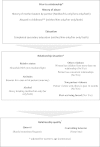Intimate partner violence among adolescents and young women: prevalence and associated factors in nine countries: a cross-sectional study
- PMID: 25059423
- PMCID: PMC4133076
- DOI: 10.1186/1471-2458-14-751
Intimate partner violence among adolescents and young women: prevalence and associated factors in nine countries: a cross-sectional study
Abstract
Background: Little is known about the prevalence of intimate partner violence (IPV) and its associated factors among adolescents and younger women.
Methods: This study analyzed data from nine countries of the WHO Multi-country Study on Women's Health and Domestic Violence against Women, a population based survey conducted in ten countries between 2000 and 2004.
Results: The lifetime prevalence of IPV ranged from 19 to 66 percent among women aged 15 to 24, with most sites reporting prevalence above 50 percent. Factors significantly associated with IPV across most sites included witnessing violence against the mother, partner's heavy drinking and involvement in fights, women's experience of unwanted first sex, frequent quarrels and partner's controlling behavior. Adolescent and young women face a substantially higher risk of experiencing IPV than older women.
Conclusion: Adolescence and early adulthood is an important period in laying the foundation for healthy and stable relationships, and women's health and well-being overall. Ensuring that adolescents and young women enjoy relationships free of violence is an important investment in their future.
Figures
References
-
- Brown SL, Bulanda JR. Relationship violence in young adulthood: A comparison of daters, cohabitors, and marrieds. Soc Sci Res. 2008;37(1):73–87. doi: 10.1016/j.ssresearch.2007.06.002. - DOI
Pre-publication history
-
- The pre-publication history for this paper can be accessed here:http://www.biomedcentral.com/1471-2458/14/751/prepub
Publication types
MeSH terms
Grants and funding
LinkOut - more resources
Full Text Sources
Other Literature Sources
Medical



